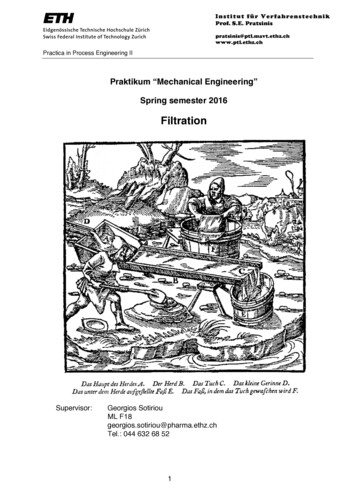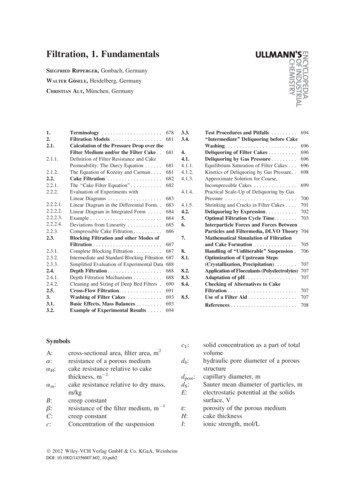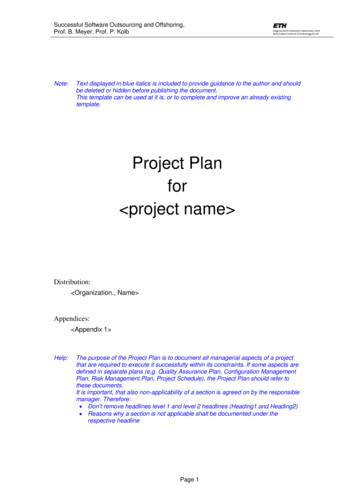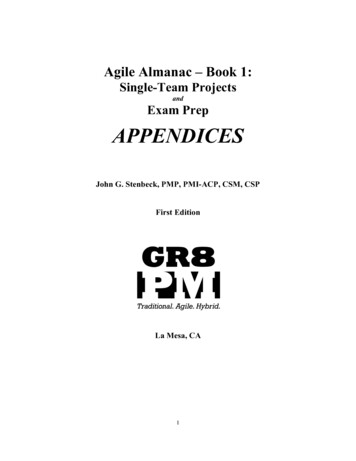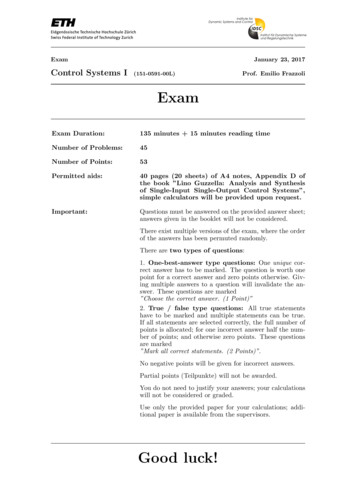
Transcription
ExamControl Systems IJanuary 23, 2017(151-0591-00L)Prof. Emilio FrazzoliExamExam Duration:135 minutes 15 minutes reading timeNumber of Problems:45Number of Points:53Permitted aids:40 pages (20 sheets) of A4 notes, Appendix D ofthe book ”Lino Guzzella: Analysis and Synthesisof Single-Input Single-Output Control Systems”,simple calculators will be provided upon request.Important:Questions must be answered on the provided answer sheet;answers given in the booklet will not be considered.There exist multiple versions of the exam, where the orderof the answers has been permuted randomly.There are two types of questions:1. One-best-answer type questions: One unique correct answer has to be marked. The question is worth onepoint for a correct answer and zero points otherwise. Giving multiple answers to a question will invalidate the answer. These questions are marked”Choose the correct answer. (1 Point)”2. True / false type questions: All true statementshave to be marked and multiple statements can be true.If all statements are selected correctly, the full number ofpoints is allocated; for one incorrect answer half the number of points; and otherwise zero points. These questionsare marked”Mark all correct statements. (2 Points)”.No negative points will be given for incorrect answers.Partial points (Teilpunkte) will not be awarded.You do not need to justify your answers; your calculationswill not be considered or graded.Use only the provided paper for your calculations; additional paper is available from the supervisors.Good luck!
Corrected
Corrected1Control Architectures and SystemsQuestion 1Mark all correct statements. (2 Points)Feedforward control systems.A .rely on precise knowledge of the plant.B .can change the dynamics of the plant.Question 2C .reject external disturbances.Mark all correct statements. (2 Points)Feedback control systems.A .can stabilize an unstable plant.B .can feed sensor noise into the system.Question 3C .can de-stabilize a stable plant.Mark all correct statements. (2 Points)All signals are scalars. The systemddt y(t) (u(t 1))2 is:A CausalC Time-InvariantB Memoryless / StaticD LinearQuestion 4Mark all correct statements. (2 Points)All signals are scalars. The system (s) e5·s ·s 1is:A CausalC Memoryless / StaticB Time-InvariantD LinearQuestion 5Mark all correct statements. (2 Points)All signals are scalars. The system y(t) t2 · u(t1) is:A LinearC CausalB Time-InvariantD Memoryless / Static
Corrected2System ModelingBox 1: Questions 6, 7Description: Consider an electric motor which you would like to operate at a constant rotationalspeed !0 . Applying a voltage U (t) results in a change in the circuit current I(t), which is governedby the di erential equationL·dI(t) dtR · I(t) · !(t) U (t) ,(1)whereby L is the circuit inductance, R its resistance and a constant relating the motor speed!(t) to an electro motor-force (EMF). The dynamics of the motor speed are given by ·d!(t) dtd · !(t) T (t) ,(2)where represents its mechanical inertia, d a friction constant and T (t) · I(t) the currentdependent motor torque.Box 2: Question 6r(t)e(t) Question 6Cu(t)Px(t)Choose the correct answer. (1 Point)Relate the variables in the block diagram above to the correct signals. !(t)A u(t) U (t), x(t) , y(t) !(t), r(t) !0I(t) U (t)B u(t) U (t), x(t) , y(t) T (t), r(t) !0T (t) !(t)C u(t) U (t), x(t) , y(t) I(t), r(t) !0I(t) !(t)D u(t) I(t), x(t) , y(t) I(t), r(t) !0U (t) !(t)E u(t) I(t), x(t) , y(t) !(t), r(t) !0T (t)y(t)
CorrectedQuestion 7Choose the correct answer. (1 Point)A colleague tells you that the circuit inductance is very small and can actually be neglected. Thearising motor model can now be represented as. . .A .a second-order system.C .an integrator.B .a first order system.D .a static system.Question 8Choose the correct answer. (1 Point)Consider the nonlinear systemdx(t) x(t) u(t)dty(t) x(t) 20 .4You are measuring a constant output y(t) 10.What is the value of x(t) and u(t)?A x(t) 20 · t and u(t) 20.B x(t) 10 and u(t) 30.Question 9C x(t) 20 and u(t) 20.D x(t) 30 and u(t) 30.Choose the correct answer. (1 Point)Given the systemdx(t) x(t)2 5 · u(t)dt4 · x(t) 12y(t) ,u(t)10you have to linearize it around the equilibrium xe 0, ue 2.Which are the state-space matrices A, b, c and d?A A 0, b 5, c 4, d 3.C A B A 5, b 5, c 2, d 3.D A 0, b 5, c 2, d 3.10, b 5, c 2, d 3.
Corrected3Linear Systems AnalysisBox 3: Question 10yThe figure below shows the step response of a second-order system.timeQuestion 10Choose the correct answer. (1 Point)Assess the bounded-input bounded-output (BIBO) stability.A BIBO unstableB BIBO stableC No conclusion possible
CorrectedBox 4: Questions 11, 12internal state xThe figure below shows the response of an internal state x of a system as an impulse is applied tothe system’s input.timeQuestion 11Choose the correct answer. (1 Point)A No conclusion about the stability is possible.B The system is unstable.C The system is asymptotically stable.D The system is Lyapunov stable.Question 12Choose the correct answer. (1 Point)A The system is BIBO stable.B No conclusion about the BIBO stability is possible.C The system is BIBO unstable.Question 13Choose the correct answer. (1 Point)Given a system with state space representation 1 10 · 2ẋ(t) 0 1· x(t) y(t) · x(t) u(t) , 1 · u(t)where 2 R. For which values of is the system asymptotically stable?A 1.B 0.C 1.D 1.
CorrectedBox 5: Question 14Description: The figure below shows the step response of a first-order system of the formẋ(t) a · x(t) b · u(t)(3)y(t) x(t) .108y(t)6420010.5Question 141.522.53t [s]3.544.55Choose the correct answer. (1 Point)Which are the values of a and b?A a 2 and b 20.B a 0.5 and b 10.C a 0.5 and b 20.D a 1 and b 10.Box 6: Question 15Description: The figure below shows the impulse responses yA (t) and yB (t) of two systems Aand B. Both systems are linear time-invariant second order systems. In addition to the responses,an unknown function f (t) and its tangential line at time t 0 is drawn in the plot to the right.1100yA (t)101234time in seconds5y(t) f (t)yB (t)y(t) f (t 0) · t f (t 0)1601234time in seconds5Question 15Choose the correct answer. (1 Point)Which are the eigenvalues A and B of both systems?ABAA 2 andB 0 j and12. B 12 j.CADA 0 j · 2 and 0 j · 2 andB B 2 j · 2 .12 j · 2 .6
CorrectedBox 7: Questions 16, 17Description: A LTI system has the form 0 01A , b 1 00Question 16,c 01 ,d 0 .Choose the correct answer. (1 Point)The system in the above equation is . . .A only observable.C observable and controllable.B only controllable.D neither observable nor controllable.Question 17Choose the correct answer. (1 Point)For x1 (t 0) 1, x2 (t 0) 0 the initial condition response of the system is . . .A y(t) 0.B y(t) h(t).C y(t) h(t) · t.D y(t) h(t) · et .
Corrected4Frequency ResponseBox 8: Questions 18, 19Description: Given a linear time-invariant system in state-space description.23231 0 028 5 · x(t) 4 0 5 · u(t)ẋ(t) 4 2 01 040 y(t) 1 0 1 · x(t) .Question 18Choose the correct answer. (1 Point)The transfer function g(s) is . . .A g(s) 2s 10s(s 4)(s 1) .C g(s) s 5s2 5s 4 .B g(s) 2s 10s2 5s 4 .D g(s) 2(s 5)s2 4s 5 .Question 19Choose the correct answer. (1 Point)The system is . . .A Asymptotically stable.B Lyapunov stable.Question 20C Unstable.Choose the correct answer. (1 Point)Given the tranfer function g(s) of a system.g(s) 3s 7s(s 1)A unit step is applied to the system’s input:u(t) h(t) .The time response y(t) is . . .A y(t) h(t) · ( 4 7t 4e t ).B y(t) h(t) · (2 7t 7e t ).C y(t) h(t) · (7D y(t) h(t) · (74t 4e t ).4t 4e t ).
CorrectedBox 9: Question 21Given the tranfer function g(s) of a system.g(s) s 3s2 0.7s 1In addition the figure below shows the four time responses A, B, C and D.y(t)diagram 1diagram 2diagram 3diagram 4444433332222111100001051015time in seconds1051015time in seconds1051015time in seconds10Question 21Choose the correct answer. (1 Point)Which of the four diagrams shows the correct step response of the system?A Diagram 3.C Diagram 1.B Diagram 4.D Diagram 2.51015time in seconds
CorrectedBox 10: Question 22Question 22Choose the correct answer. (1 Point)Select the transfer function L(s) which matches the Bode Plot given above:A L(s) 0.01 ·(s 10)2s 0.1B L(s) 10s 0.1C L(s) 100.1 sD L(s) s 100(s 0.1)(s 100)Question 23Choose the correct answer. (1 Point)What is the steady state output of the systemẋ(t) x(t) u(t),when u(t) sin(!t)?A yss (t) ! cos(!t) sin(!t)1 ! 2B yss (t) p 11 ! 2C yss (t) sin(!t2sin(!t) ! cos(!t)1 ! 2arctan(!))y(t) x(t),(4)
CorrectedBox 11: Question 24Consider the following Bode plot for a loop transfer function L(s):Question 24Choose the correct answer. (1 Point)How many poles and zeros does L(s) have?A L(s) has 2 poles and 0 zeros.B L(s) has 4 poles and 2 zeros.C L(s) has 3 poles and 2 zeros.D L(s) has 3 poles and 0 zeros.
CorrectedBox 12: Question 25Consider the following Bode plot of a transfer function g(s):Question 25Choose the correct answer. (1 Point)Select the transfer function which matches the Bode plot.A g(s) 20s 1B g(s) 10s 1C g(s) 20s 1D g(s) 10s 1
Corrected5Polar Plot and Closed-Loop StabilityBox 13: Question 26The Nyquist plot for a loop transfer function L(s) with two unstable poles is shown below on theleft. On the right is a feedback configuration for the closed loop system.Question 26Mark all correct statements. (2 Points)Which of the following statements are true about the closed loop system T (s) A The closed loop system T (s) is stable when k 1.B The closed loop system T (s) is unstable when k 2.C The closed loop system T (s) is unstable when k 1.D The closed loop system T (s) is stable when k 2.kL(s)1 kL(s) ?
CorrectedBox 14: Question 27The Bode plot for a plant transfer function P (s) is given below.Question 27Choose the correct answer. (1 Point)Which of the controller designs will produce a stable closed loop system?A C(s) 0.01s 10.001s 1B C(s) 10.01s 1C C(s) 0.1D C(s) 10.0
CorrectedBox 15: Question 28The Nyquist plot for a loop transfer function of the formL(s) k(s p1 )(s p2 )(s p3 )(5)is given below.Question 28Choose the correct answer. (1 Point)How many unstable poles does the closed loop system T (s) A T (s) has 2 unstable poles.B T (s) has 0 unstable poles.C T (s) has 1 unstable pole.D Not enough information is provided.L(s)1 L(s)have?
CorrectedBox 16: Question 29The bode plot for a system with transfer function g(s) is given below.Question 29Mark all correct statements. (2 Points)Select all answers that correctly classify the stability of the system.A g(s) is unstable.B g(s) is asymptotically stable.C g(s) is Lyapunov stable.D g(s) is bounded input bounded output (BIBO) stable.
CorrectedBox 17: Question 30Consider the following Nyquist plot of an open loop gain L(s):Question 30Choose the correct answer. (1 Point)Select the transfer functions which match the Nyquist plot.A L(s) 10(s 1)3B L(s) 10(s 1)3C L(s) 10(s 1)3D L(s) 10(1 s)3
CorrectedBox 18: Question 31Consider the system described by the following block diagramr eC(s)P (s)y–whereP (s) Question 311,10s 1C(s) k.Choose the correct answer. (1 Point)Determine the smallest positive gain k such that the feedback system is stable and, when r(t)is a unit step, limt!1 e(t) 0.1.The smallest positive gain k is:A 10B 2C 1D 5E 9
CorrectedQuestion 32Choose the correct answer. (1 Point)We are given the transfer function:g(s) (s 4).(s4 9s2 )Which of the following is the root locus plot of g(s)?Root Locus151010-1Imaginary Axis (seconds )Imaginary Axis (seconds-1 )Root eal Axis (seconds -1 )-8-6-4-2D102Imaginary Axis (seconds-1 )Imaginary Axis (seconds-1 )350-5-10-8-6-4-2024688104681010-1-3-1010Real Axis (seconds -1 )ERoot Locus1510Imaginary Axis (seconds-1 )6-2B50-5-10C4Root Locus15-15-102-1Root Locus-15-100Real Axis (seconds )-8-6-4-202Real Axis (seconds -1 )46810-8-6-4-202Real Axis (seconds -1 )
Corrected6Feedback Control and SpecificationsQuestion 33Choose the correct answer. (1 Point)For the following system, you have the choice between implementing two di erent sensors:y1 (t) x1 (t) or y2 (t) x2 (t).ẋ(t) Which sensor should you choose?A y2 (t)B y1 (t) 30 10x(t) u(t)21
CorrectedBox 19: Questions 34, 35, 36Consider the block diagram given below to answer the following three questions:r C(s)yP1 (s) P2 (s)Question 34Choose the correct answer. (1 Point)Suppose P1 (s) s 2 1 , P2 s 1 1 , and C(s) 2. Which of the following choices is the correcttransfer function, G(s) Y (s)/R(s), from r to y?B G(s) 4s 14(s 2)(s 1)C G(s) 4(s 1)(s 1)2A G(s) Question 35D G(s) 4(s 1)(s 1)2E G(s) 4s 1Choose the correct answer. (1 Point)Is the system defined in the above problem internally stable?A No.B Yes.Question 36Choose the correct answer. (1 Point)Now assume instead that P1 (s) P2 (s) P (s) for some P (s) and that C(s) is stable. Which ofthe following statements is true?A The system is internally stable if and only if P (s) has no zeros with positive real part.B The system is NOT internally stable for any choice of P (s).C The system is internally stable for any choice of P (s).D The system is internally stable if and only if P (s) is stable.
CorrectedBox 20: Question 37Consider the state-space system below, where a is a real parameter:ẋ(t) 11 y(t) 2Question 37 0ax(t) u(t)41 a x(t)Choose the correct answer. (1 Point)Is the system stabilizable for a 0?A No.B Yes.Question 38Mark all correct statements. (2 Points)Mark all of the following statements about control limitations that are true.A The dominant right-half-plane pole puts a lower limit on the system’s bandwidt
Exam January 23, 2017 Control Systems I (151-0591-00L) Prof. Emilio Frazzoli Exam Exam Duration: 135 minutes 15 minutes reading time Number of Problems: 45 Number of Points: 53 Permitted aids: 40 pages (20 sheets) of A4 notes, Appendix D of the book ”Lino Guzzella: Analysis and Synthesis of Single-Input Single-Output Control Systems”,
